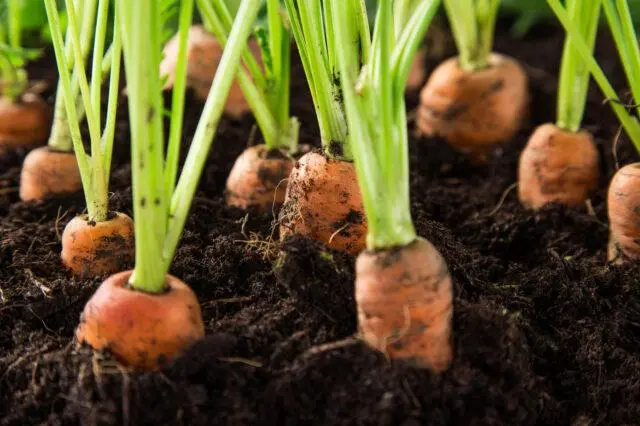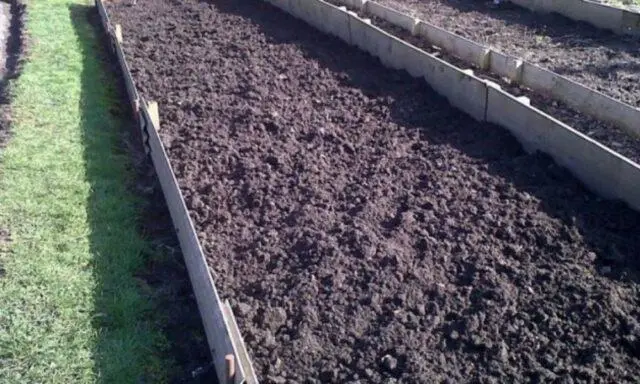Contents
Many novice gardeners at the end of the season are faced with a problem when carrots crack in the ground in the garden. This is mainly due to non-compliance with the rules of agricultural technology. And in order to prevent this in the next season, you need to find out the root cause of the problem and eliminate it. Otherwise, carrots will crack constantly. You should also familiarize yourself with which varieties are more stable and retain the integrity of the fruit even with errors in care.

Cracked root crops are not subject to long-term storage
Why do carrots crack and burst in the ground in the garden
There are several main reasons that cause carrots to crack in the ground. All of them can be avoided if the gardener provides care and growing conditions, taking into account the basic requirements of the crop.
Incorrect watering
Carrots belong to the category of plants that are demanding on watering. If this rule is violated, it will crack. It is necessary to irrigate a bed with a root crop regularly in the absence of seasonal rains, but at the same time avoid overflows. In the spring, after the snow melts, the soil is saturated with moisture. And during the active growing season, carrots do not need watering.
But with the advent of summer, moisture gradually evaporates, and the development of the root crop slows down. Rain or heavy watering after a long drought leads to the fact that the pressure in the soil increases dramatically. As a result, the root cells cannot cope with the load and burst from the inside. This causes tissue divergence, carrots crack
Incorrect fertilization
An excess of nutrients in the soil or an incorrectly chosen dosage without taking into account the stage of crop development can also provoke a violation of integrity.
On the bed intended for planting carrots, you can not make fresh manure. This is due to the fact that the process of its decomposition takes place at a high temperature. And this can lead not only to cracking of the fruit, but also to provoke the death of the plant.
late harvest
The reason why the carrots cracked lengthwise in the garden may be an untimely harvest. This is especially true for early and medium cultivars. The growing season for these species ends at the end of summer. By this time, metabolic processes in the tissues of the fetus slow down.
During this period, carrots no longer require a lot of moisture and nutrients. And a long stay in the ground leads to the fact that the plant cannot use them in full, which leads to cracking of the fruit.

The crop should not be in the ground after ripening
Unsuitable soil
For the full development of the root crop, loose soil with good aeration is needed. When planting carrots in clay soil, the vegetable experiences strong pressure. And during the growing season, trying to overcome it, it begins to crack.
Also not suitable for growing carrots and greasy soil. In this case, the root cells increase excessively in size. As a result, their walls do not withstand the load and burst, as a result, the carrots crack.
Excess nitrogen
This crop does not respond well to excess nitrogen in the soil. Feeding with a high content of this component is possible only at the beginning of the growing season, when the plant grows a leaf rosette. At the stage of root formation, excess nitrogen provokes excessive cell growth. This leads to the fact that the tissues of the carrots become loose, increasing their susceptibility to the level of moisture in the soil. And any fluctuations lead to the appearance of cracks.
What to do to prevent carrots from cracking
To prevent carrots from cracking in the ground, you need to follow certain rules of care. Particular attention should be paid to site preparation, watering, fertilizing, and it is also important to harvest the crop in a timely manner, taking into account the ripening period of the variety.
If the site has dense clay soil, then it must first be prepared. To do this, it is necessary to add river sand and peat at the rate of 10 kg per square meter. m and dig.
If this measure did not bring the desired result, and the carrots still crack during growth, then experienced gardeners recommend preparing beds from foreign land on their own. To do this, it is necessary to dig holes 20-40 cm deep and fill them with nutrient soil mixture. It should consist of soddy soil, leafy soil, peat, sand and humus in a ratio of 2: 1: 1: 1: 0,5. After that, the soil must be watered and the crop should be planted.
So that the carrots do not crack, the beds can be made bulk. In this case, a layer of nutritious, well-drained soil should be laid on top of dense soil. For planting, only varieties that form a short fruit are suitable. Otherwise, subsequently, the underground part will reach a dense layer of earth, and the fruits will begin to crack.

The bed needs to be prepared in advance
In regions where summers are rainy and cool, it is recommended to plant cauliflower or lettuce between rows of carrots. These plants are moisture-loving and will be able to balance the balance.
During prolonged drought, moderate watering can prevent fruit cracking. You need to spend it often every two days, but little by little. If the gardener can only come to the dacha for the weekend, then the garden should be watered moderately for two days in a row.
It is necessary to use organic matter and nitrogen fertilizers when growing this crop only in spring and in the first month of summer. Subsequently, fertilizers with a high potassium content can be used. You can also use an extract based on wood ash. To do this, pour 200 g of the component into 1 liter of hot water and leave for a day. After the time has elapsed, add the volume of liquid up to 10 liters and mix thoroughly. The resulting nutrient solution should be watered between rows.
To prevent cracking of the root crop, it is necessary to harvest in a timely manner. You can determine the timing, depending on the length of the growing season of the variety. This information is contained on the seed packet, where the manufacturer indicates the recommended planting and harvesting times.
Varieties of carrots that do not crack
There are varieties of culture that do not crack. Moreover, the fruits retain their integrity even despite the mistakes made in care.
These include:
- Alenka. The length of root crops reaches 15 cm. The duration of the growing season is 100 days. The fruits are sweetish in taste, juicy. The variety is suitable for long-term storage. It is resistant not only to cracking, but also to common diseases.

The yield of Alenka is 10 kg per 1 sq. m
- Carotel. The variety is characterized by a high content of carotene. Suitable for baby and diet food. Root crops are short, cylindrical, with a blunt tip, their length reaches 15 cm.

The harvested Karoteli crop is stored until next season
- Nantes 4. The variety ripens in three months from the moment of germination. The fruits are even, cylindrical, with a rounded tip, do not crack. Nanskaya 4 has a rich orange tint. The length of the roots is about 16 cm.

Nanskaya 4 tolerates transportation and long-term storage well
- Shantenay Royal. The variety easily adapts to any climatic conditions. Vegetation period is 120 days. The length of root crops reaches 17 cm. The duration of storage of the crop is nine months.

Shantenay Royal variety is resistant to cracking and blooming
Application of cracked carrots
Fruits with cracks can not be kept fresh for a long time. In this case, it is recommended to clean them, wash thoroughly, and then dry them slightly. After that, the carrots need to be grated and the resulting vegetable mixture should be decomposed into Zip bags. It is necessary to store the workpiece in the freezer.
In this form, the root crop retains most of the vitamins and minerals. You can add a vegetable to salads, first and second courses.
Conclusion
Knowing the reasons why carrots crack, you can avoid this problem. To do this, it is necessary to irrigate taking into account the growing region and weather conditions, properly prepare the site, dosed top dressing and harvest in a timely manner. Compliance with these rules ensures that the root crops will not only be tasty, but will not crack.













